20. Februar 2023
Swiss Peaks 360, Prepping for the Next Edition
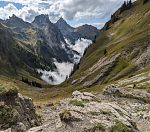 Poised to experience the Swiss Peaks 360 foot race again in 2023! An epic journey through Valais, covering 360 km and an excess of 26,000 m of vert in less than a week. One thing is certain: preparation is necessary. As a self-coached hobby-athlete, sketching the training remains up to me.
Poised to experience the Swiss Peaks 360 foot race again in 2023! An epic journey through Valais, covering 360 km and an excess of 26,000 m of vert in less than a week. One thing is certain: preparation is necessary. As a self-coached hobby-athlete, sketching the training remains up to me.
First things first
Prior to any planning of training ahead, I need to understand where I am right now. I need to assess the demands of the race relative to what I want to achieve. This in turn is tied to why I am doing the race in the first place. Ony when rough answers to these questions are in place, it’s worth sketching out how to get there. So much to the abstract.
Why: the purpose
Concretely, let’s start with why. Just like Simon Sinek’s book with the same title. Just like Neil Thubron puts Purpose as the first P in his “7P formula” towards achieving Big Goals. Really: What makes me want to hike & run through pretty much the whole canton of Valais, again? It’s a surprisingly difficult question. But fundamental: I need to still be able to remember and believe in this purpose on day 6, not only while producing fluffy words while sitting comfortably on a chaise lounge at home.
First, and I still know this deep down, I love being in the mountains. The mountains are big, and we are small. The mountains have been around for a long time, and we have not. The mountains inspire awe. This is nothing new, and been one of the prime drivers behind my decision to sign up for the Swiss Trail Tour in 2021 (Swiss Trail Tour, Beginning or Comeback?). I am repeating myself, which is a good thing: three years in Switzerland, and my love remains unbroken. The spectacular scenery of Valais is itself a reason to return. Additionally, there will be opportunities to experience sections in daylight that I was only able to “see” during the night in the 2022 edition, and opportunities to revisit places during different weather conditions.
Second, setting my sight at a big race motivates me to train consistently. This is much less about the race itself, but much more about having a long term goal that is sufficiently Big such to make me pick up myself, have a dash around the local fields, forests, and hills. Frequently. I know that training and fresh air makes me feel good either way, but the race makes me get out of the door.
Third, the demands of the race require me to train specifically on trails, occasionally together, which I hope to do more frequently with others this year. I got more engaged in the trail running community this year (taking over organisation of the local crew of the trail-maniacs), and this gives me opportunities to connect with like-minded hobby athletes. I can do that without the race, of course, but the race-specific demands will motivate me to set time aside.
Fourth, this race is going to be a proper challenge, and I enjoy that for a challenge requires me grow. Yes, I have completed this race before. But if anything, the second time is going to be harder because I cannot rely on the motivation to complete it for the first time. However, I want to take the lessons learned; concretely this time complete the race with my toes in decent shape, and to prepare and execute such that I can arrive before Saturday noon.
Fifth, I want to give back. For every 25 meters climbed, I will donate an amount to charity, such to support more environmentally friendly and sustainable forms of mobility than are in use today.
All of these five (sub)goals, fit nicely into my overall running purpose, which I had formulated in one of the previous years, and still remains unchanged:
Enjoy running out in the nature, savouring the moment, strengthening mind and body to maintain and fuel a positive outlook on life for decades, practicing self-control through deliberate, consistent training towards achieving stretch goals all whilst making friends and contributing to the running community.
Enough on purpose.
Where: the baseline
Where am I right now with my training? That is a prerequisite for making any plans on getting somewhere: need to know first where we are starting from. That’s less obvious a question to answer than you might think.
How to establish a baseline? I can use whatever data I have (objective), I can take into consideration where I feel I am right now (subjective), and I can take into account where one would expect a runner with a background like me to be (collective). This way of framing is inspired by the three components of the feedback loop described by Matt Fitzgerald in his book on “Brain Training” [3]): subjective feedback (one’s own feeling), objective feedback (evidence) and collective feedback (established wisdom). In order to narrow down where I am right now, I think that most promising are subjective feeling, as well as past training data.
As for the subjective assessment, it’s mid-February and I have gotten comfortable again with getting out for runs frequently, and covering longer distances, albeit at a slower, “forever” pace. Running at high intensities, whether uphill, downhill is uncomfortable, and the idea of it alone gives rise to the “procrastination instinct”.
Objectively, I could do a performance test (measuring VO2max, lactate threshold, FatMax, and other indicators). Such a test would likely inform me about some strengths and weaknesses, but these tests are expensive and difficult to interpret; hiring a coach to help make sense out of these numbers, and put them into context is an option, but also not cheap either.
Instead, l can look at past effort. Effort does not guarantee performance, however achieving performance is unlikely without putting in the effort. I can assume that the effort somehow translates into performance, whilst understanding that sometimes less is more when it comes to training.
I can look back at over almost nine years of recorded runs. I can zoom in on the more recent years, quarters, months, and weeks. I can compare the training that happened already this season against what I had done in the previous season up to that point. Beyond volume, there are important qualitative aspects such as intensity distribution, terrain, quality of the workouts: none of these aspects will be covered in simple aggregations of moving time, distance, and elevation gain.
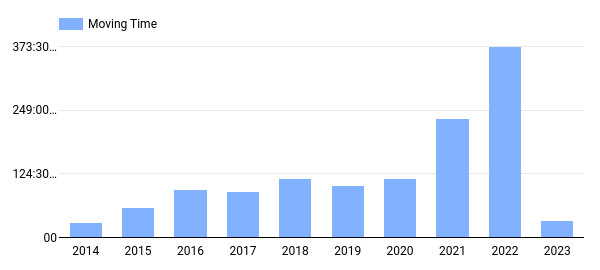
When it comes to moving time (running only), the past two years (2021 and 2022) were fairly similar if I subtract the time it took for the race in 2022. Including hiking does not change the picture of volume much either.
However, the quarterly and monthly breakdowns indicate clearly that I spent considerably more effort preparing for the Swiss Peaks 360 in 2022 than for the Swiss Trail Tour in 2021. Gauging from the charts, I spent about 8 hours per week on average when training for Swiss Peaks in 2022, think: one hour per day.
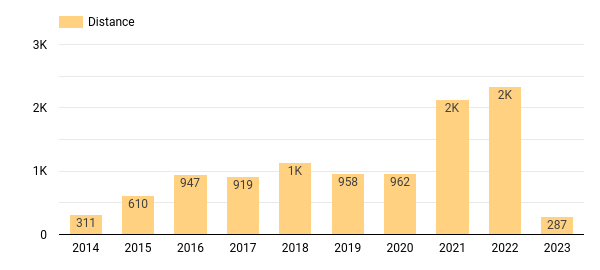
For running, distance and elevation gain were also comparable between 2021 and 2022, again if I ignore the Swiss Peaks race in 2022. The time on my feet in January 2023 is up +36% against January 2022. In conclusion, from a perspective of pure volume, I would expect to be roughly at a similar point as I was a year ago. If I only remembered how that felt a year ago…
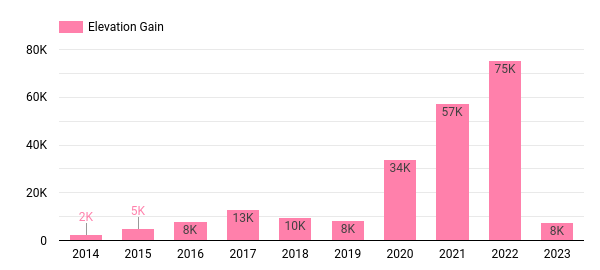
However, in the recent weeks, I felt fairly sluggish. I have not done much speed work in 2023. No hill sprints. Not many strides. This is different to January and February 2022, where I regularly put in some hill sprints, strides. As my training logs prove. Conclusion? When looking at the foundations of both speed and endurance, I am likely behind in general speed and ahead in general endurance when compared to last year.
This is a hand-wavy assessment. I could drill down into the data, or I could do some performance testing. But for the purpose at hand — sketching the general training plan ahead — I believe this to be sufficient: I am at a good starting point when it comes to long, slow efforts including uphill sections. I am not yet able to work much at high intensities.
What: the demands
Where do I need to be? That is a prerequisite for making any plans on getting somewhere: need to know first where we are heading towards. This year, I have an advantage compared to last year. Having completed all stages of the Swiss Peaks 360 last year, I know the demands and the course better, although I must be diligent and not consider this a reason for complacency when it comes to more detailed race preparation.
I experienced the long and steep uphill sections, the long and technical downhill sections, significant amounts of rocky terrain as well as muddy sections depending on weather conditions: overall the percentage of the course I consider runnable is pretty low, and good hiking skills are key. Plus of course the demands of balancing sleep against time on my feet, and the ability to also keep moving during the night. I experienced the challenges of refuelling. On the mental side, the race requires staying alert and focused as well as requiring an unwavering resolve to leave comfortable aid stations.
In summary, the race demands both strength and endurance as well as skills in two modalities: hiking and running. The mental element is key: this means building up confidence, as well as nailing the logistics ahead of the race, and taking good care of myself during the race. This challenge, again, will not be a quest for perfection. This race will be a quest for avoiding big mistakes.
What: the constraints
For a hobby athlete, there is only so much time and energy you can devote to your sport. At some point something else has to give: is it worth the sacrifice? It is better to think up front how badly you want it, and where to draw boundaries around your hobby. Just like you are probably better off drawing boundaries around your work.
In my case, I need to work around holidays, weddings, dance festival(s), weeks of oncall duty, all of which affect the time and energy available for training. Additionally, I typically put in high amounts of energy into work during weekdays. Overall, I come to believe, I am a minimalist among the ultra trail runners when it comes to the amount of time I invest into training; around an hour a day. This is unlikely to change this year. Hence the focus must be on quality, not sheer quantity. Easier said than done.
How: the training plan
My training plan is anchored around the following quote from “The Science of Running” [4], which covers three training principles [5] (overload, specificity, reversibility, but not individuality):
Start backwards. Work the extremes. Bring it together. Never leave anything behind. Progress everything. (Steve Magness)
It’s not clear to me when I seriously started training this season. Whilst I signed up for the race already in November, and picked up regular running in the last week of October 2022 after several weeks of rest, I only took a more focused approach in January 2023. Either way, it’s a difference of 10 weeks of basic training without much progression.
The plan is to break down this season into 37 (47) weeks of training in total: 15 (25) weeks of base training, 11 weeks of support training, and 9 weeks of specific training. I am loosely deriving the concepts of “base”, “support” and “specific” from the periodization approach layed out by Steve Magness [4]. Not all of the 37 weeks are pure training, I have to work around 3-4 weeks oncall (time & energy constraints), as well as 2 weeks vacation (running not a priority).
In the “base period”, I am working on general endurance (think: long and slow) and general speed (think: steep and fast), as well as on my weaknesses (downhill technique, running economy). In the “support period”, I am working on ability to sustain higher intensities for longer periods of time (think: tempo runs, fartlek run). In the “specific period”, I am focusing on race-specific training such as long day hikes, long uphill sessions with poles, night runs, more vertical, and volume.
These periods are not sharp blocks, but rather these periods help me to be intentional in moving from general training to specific training, to be intentional in integrating more training on race-specific terrain and in race-specific modalities. These periods also help me to create a healthy sense of urgency, and are less overwhelming than a single block of 37 weeks.
Base training: what is next
How to continue with the base training? From October 2022 to January 2023, I have mostly focused of re-establishing more or less consistent training habits, aiming at & capping weekly distance at 50 km. In January, prior to the Weisshorn Halbmarathon (Arosa), I spent a few weeks focusing on vertical gain.
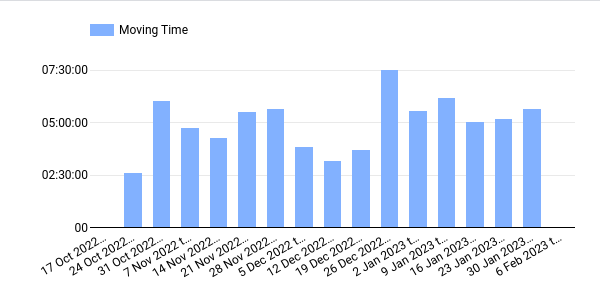
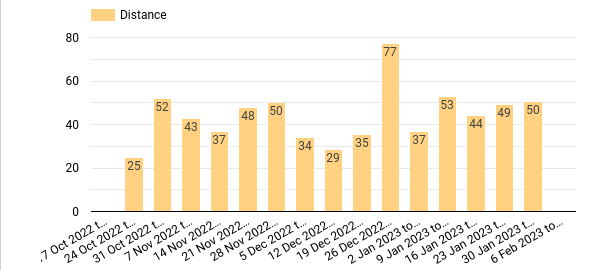
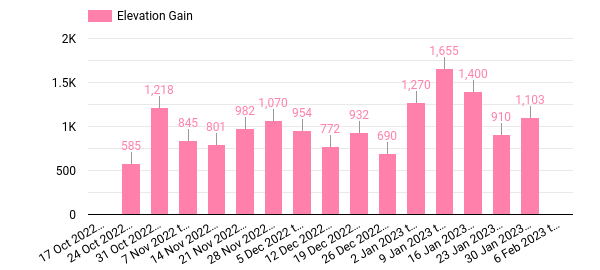
What the above charts don’t show: I have mostly trained at low intensities, working on long and slow efforts, and occasionally on frequent efforts. I have not yet worked much on my weaknesses (such as technical downhills), and not much on general speed. Thus, in the remaining weeks of February and in March, I will focus on seeking out technical downhill trails; I will incorporate hill sprints, strides, drills, track training, and some intervals; even if that means dialing down on distance and long runs.
References
[1] Sinek, Simon. 2011. Start with Why: How Great Leaders Inspire Everyone to Take Action. Reprint edition. Portfolio.
[2] Thubron, Neil Anthony. 2017. Yucan: Achieve Any Big Goal Using the 7P Formula for Success. CreateSpace Independent Publishing Platform.
[3] Fitzgerald, Matt. 2007. Brain Training For Runners: A Revolutionary New Training System to Improve Endurance, Speed, Health, and Results. Penguin.
[4] Magness, Steve. 2014. The Science of Running: How to Find Your Limit and Train to Maximize Your Performance. Origin Press.
[5] Mazzeo, Robert. n.d. “Science of Exercise | Coursera.” Coursera. Accessed May 23, 2020. https://www.coursera.org/learn/science-exercise.